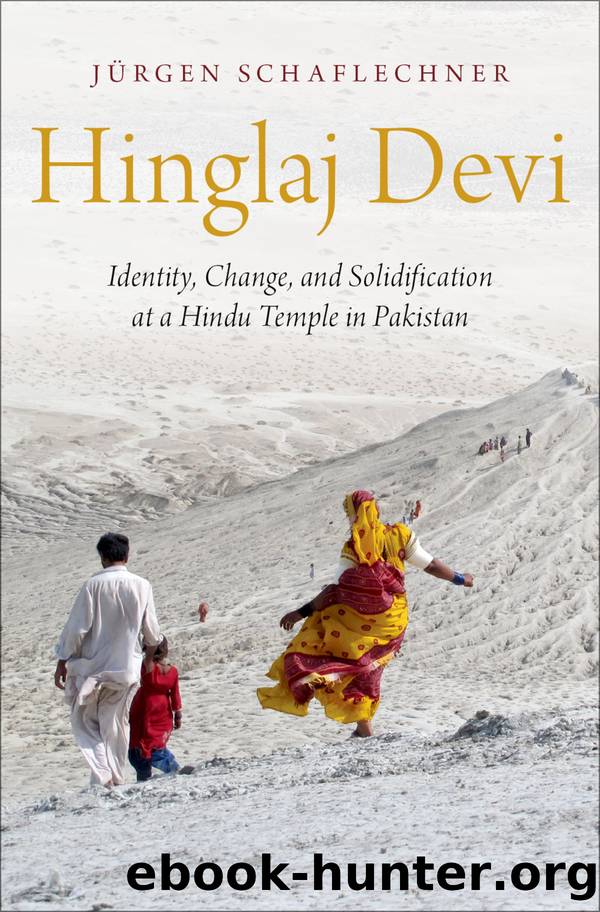Hinglaj Devi by Schaflechner Jurgen;

Author:Schaflechner, Jurgen;
Language: eng
Format: epub
Publisher: Oxford University Press USA - OSO
Published: 2017-08-15T00:00:00+00:00
Rajendra brought five flat stones with him that he had picked up from the riverbed of the Hingol. Two of them—in his reckoning, images of Bhairava and Hinglaj—were installed in the newly constructed temple in his hometown in Mandapi. Another one he placed in his family shrine in Jaipur, and two he presented to his family. Other Charans were puzzled by his interpretation and did not support the idea that it is absolutely necessary to have been at Hinglaj to establish one of her temples. For Rajendra, however, these stones are tangible, divine markers with the ability to separate the real from the artificial temples. To support this idea, he links his own story to a corpus of oral narratives found in a few parts of Rajasthan, which relate that only those people who had come back from the pilgrimage could establish a Devi temple. For him, it is only these temples that are the real (Hin. asal) places of the Goddess.
Rajendra’s description is full of miracles, and he found many small signs of divine intervention on the way. His mytho-historic account of the journey was an encouragement for many around him. The video he took of the trip was widely circulated among the devotees of Hinglaj, encouraging others to apply for visas. This also served as advertisement for the work of the HSM, who benefitted from the circulation as well. After his trip, Rajendra gained a certain local celebrity status because of this adventure, and, according to him, people even started to approach him for advice. But Rajendra was conscious about his newly gained position within his village and even within the entire Charan society. Once when I asked Rajendra what had changed for him following the pilgrimage, he simply repeated the question back to me, asking me how I felt as someone who had been to Hinglaj and was now staying in a Charan community. The first thing that came to my mind was the immense hospitality and the respect with which people treated me. This answer was enough for Rajendra. He added that this was the blessing of the Goddess, and if I wanted an answer to how the lives of people change after they go to Hinglaj, I should just look at my own situation.
Rajendra also pointed out that his newfound status was mainly due to the difficulties of obtaining a visa for Pakistan. “If the border were not there, then people would not value the pilgrimage so much,” he once said. For him, the main power of the yātrā lies in the effort that people put into reaching the place, as he emphasized in a conversation in 2011:
Whatever you want to get in this world, you have to work for it. The bigger the thing is that you wish for, the more you need to work for it. But this is not only hard work; it also means you need devotion. The old pilgrimage was difficult, the pilgrimage now is difficult, and it seems that in the future, too, it is going to be difficult.
Download
This site does not store any files on its server. We only index and link to content provided by other sites. Please contact the content providers to delete copyright contents if any and email us, we'll remove relevant links or contents immediately.
| Anthropology | Archaeology |
| Philosophy | Politics & Government |
| Social Sciences | Sociology |
| Women's Studies |
The Secret History by Donna Tartt(16605)
The Social Justice Warrior Handbook by Lisa De Pasquale(11485)
Thirteen Reasons Why by Jay Asher(7777)
This Is How You Lose Her by Junot Diaz(5747)
Weapons of Math Destruction by Cathy O'Neil(5027)
Zero to One by Peter Thiel(4815)
The Myth of the Strong Leader by Archie Brown(4783)
Promise Me, Dad by Joe Biden(4439)
Stone's Rules by Roger Stone(4409)
Beartown by Fredrik Backman(4398)
How Democracies Die by Steven Levitsky & Daniel Ziblatt(4391)
The Fire Next Time by James Baldwin(4336)
100 Deadly Skills by Clint Emerson(4069)
A Higher Loyalty: Truth, Lies, and Leadership by James Comey(4024)
Rise and Kill First by Ronen Bergman(4006)
The David Icke Guide to the Global Conspiracy (and how to end it) by David Icke(3874)
The Farm by Tom Rob Smith(3868)
Secrecy World by Jake Bernstein(3773)
The Doomsday Machine by Daniel Ellsberg(3725)
